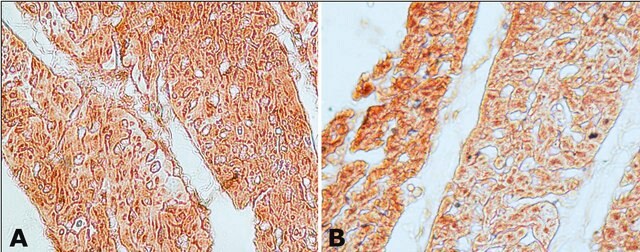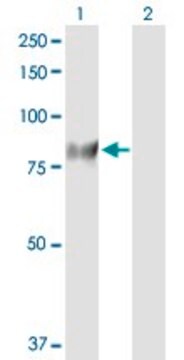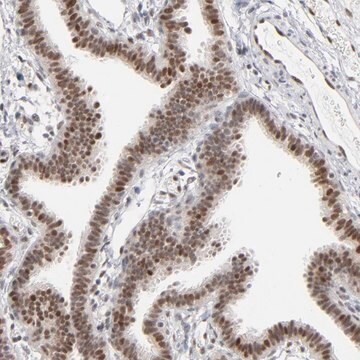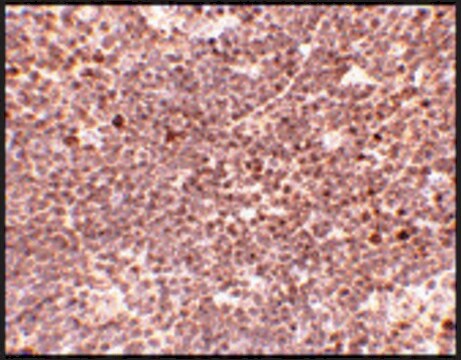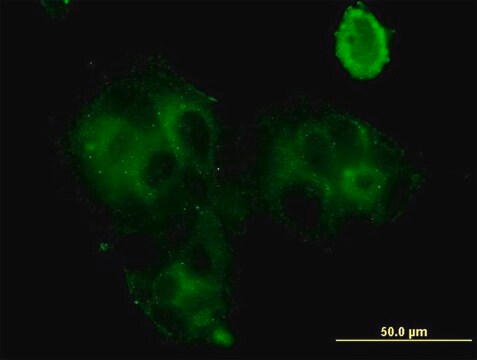推荐产品
生物源
rabbit
品質等級
共軛
unconjugated
抗體表格
IgG fraction of antiserum
抗體產品種類
primary antibodies
無性繁殖
polyclonal
形狀
buffered aqueous solution
分子量
~80 kDa
物種活性
mouse, rat, human, bovine
包裝
antibody small pack of 25 μL
加強驗證
independent
Learn more about Antibody Enhanced Validation
技術
immunohistochemistry (formalin-fixed, paraffin-embedded sections): 1:100 using trypsin-treated human, bovine and mouse heart tissue
immunoprecipitation (IP): 5-10 μg using 60-120 μg of a cytosolic fraction of rat brain
western blot: 1:10,000 using cytosolic fraction of rat brain
運輸包裝
dry ice
儲存溫度
−20°C
目標翻譯後修改
unmodified
基因資訊
human ... GUCY1A3(2982)
mouse ... Gucy1a3(60596)
rat ... Gucy1a3(497757)
一般說明
The enzyme consists of α and β subunits of ~80kDa and ~70kDa respectively. Both the units are required for catalytic activity. The N-terminal domains of the subunits are essential for the stimulation of the enzyme by NO. Dimerization is mediated by the central portion of GC. The C-terminus domain of both subunits forms the catalytic domain.
免疫原
synthetic peptide corresponding to amino acid residues 673-690 of rat soluble Guanylyl cyclase α1, conjugated to KLH with glutaraldehyde. The corresponding human sequence differs by 2 amino acids.
應用
Anti-Guanylyl Cyclase α1 antibody produced in rabbit is suitable for immunohistochemistry at a working dilution of 1:100 using trypsin-treated human, bovine and mouse heart tissue and immunoprecipitation at 5-10μg concentration using 60-120μg of a cytosolic fraction of rat brain. It is also suitable for western blot analysis using cytosolic fraction of rat brain at a working dilution of 1:10,000.
It was used as a primary antibody for immunohistochemical:
It was used as a primary antibody for immunohistochemical:
- localization of α1 subunits of sGC (soluble guanylate cyclase) in the guinea pig gastrointestinal tract
- detection of expression of sGC in the vasculature of rat skeletal muscle
- localization of the functional subunit of NO receptors, sGCα1 in guinea pig caecum
生化/生理作用
Guanylyl cyclase (GC) catalyzes the conversion of guanosine-5′-triphosphate (GTP) to cyclic guanosine-3′,5-monophosphate (cGMP) and pyrophosphate. This reaction requires Mg2+ or Mn2+.
Guanylyl cyclase (GC) catalyzes the conversion of guanosine-5′-triphosphate (GTP) to cyclic guanosine-3′,5-monophosphate (cGMP) and pyrophosphate. This reaction requires Mg2+ or Mn2+.†† The enzyme (GC) is a major physiological receptor for nitric oxide (NO), an important intra- and intercellular membrane-permeant signaling molecule. Gaseous NO binds to Fe2+ in the prosthetic heme group of the enzyme. NO binding is followed by disruption of the β1 subunit histidine105 bond to iron and activation of the enzyme. GC forms a complex with NO and cGMP and regulates smooth muscle relaxation, inflammation, platelet adhesion and aggregation, pulmonary physiology and neuronal function. It is an important target for NO-releasing and non-NO-releasing activator drugs in human cardiovascular therapy.
外觀
Solution in 0.01 M phosphate buffered saline, pH 7.4, containing 15 mM sodium azide
免責聲明
Unless otherwise stated in our catalog or other company documentation accompanying the product(s), our products are intended for research use only and are not to be used for any other purpose, which includes but is not limited to, unauthorized commercial uses, in vitro diagnostic uses, ex vivo or in vivo therapeutic uses or any type of consumption or application to humans or animals.
未找到合适的产品?
试试我们的产品选型工具.
儲存類別代碼
12 - Non Combustible Liquids
水污染物質分類(WGK)
WGK 1
閃點(°F)
Not applicable
閃點(°C)
Not applicable
Gary W Wilson et al.
The European journal of neuroscience, 31(11), 1935-1945 (2010-06-10)
Most biological effects of nitric oxide (NO) in the brain are mediated by guanylyl cyclase-coupled NO receptors, whose activation results in increased intracellular cGMP levels. Apart from protein kinase activation little is known about subsequent cGMP signal transduction. In optic
Soluble guanylate cyclase: the forgotten sibling
Hobbs AJ
Trends in Pharmacological Sciences, 18(12), 484-491 (1997)
S Iino et al.
Neurogastroenterology and motility : the official journal of the European Gastrointestinal Motility Society, 21(5), 542-550 (2009-01-30)
Nitric oxide (NO) is an inhibitory signalling molecule in the gastrointestinal (GI) tract that is released from neurons and from leucocytes during inflammation. NO stimulates soluble guanylate cyclase (sGC), elevates cyclic guanosine 3',5'-monophospate (cGMP), and subsequently activates cGMP-dependent protein kinase
M Oppermann et al.
British journal of pharmacology, 155(3), 335-342 (2008-07-01)
The regulation of vascular soluble guanylyl cyclase (sGC) expression by nitric oxide (NO) is still under discussion. In vitro, NO has been shown to downregulate the expression of sGC but it is unclear if this mechanism is operative in vivo
Gwennan André et al.
Journal of the American Heart Association, 3(3), e000852-e000852 (2014-06-19)
Increasing evidence implicates overactivation of RhoA as a critical component of the pathogenesis of hypertension. Although a substantial body of work has established that Rac1 functions antagonize RhoA in a broad range of physiological processes, the role of Rac1 in
我们的科学家团队拥有各种研究领域经验,包括生命科学、材料科学、化学合成、色谱、分析及许多其他领域.
联系技术服务部门
